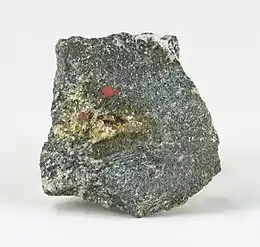| Bukovite | |
|---|---|
 Bukovite: metallic grayish-brown grains are noted by the two red dots | |
| General | |
| Category | Selenide - Bukovite group |
| Formula (repeating unit) | Tl2(CuFe)4Se4 |
| IMA symbol | Bko[1] |
| Strunz classification | 2.BD.30 |
| Dana classification | 2.5.5.2 |
| Crystal system | Tetragonal |
| Crystal class | Ditetragonal dipyramidal (4/mmm) H-M symbol: (4/m 2/m 2/m) |
| Space group | I4/mmm |
| Unit cell | V = 216.58 Å3 |
| Identification | |
| Color | Grayish-brown |
| Cleavage | Distinct/Good: Good on {001} imperfect on {100} |
| Mohs scale hardness | 2 |
| Luster | metallic |
| Diaphaneity | opaque |
| Specific gravity | 7.40 (calculated) |
| References | [2][3] |
Bukovite is a rare selenide mineral with formula Tl2Cu3FeSe4. It is a brown to black metallic mineral which crystallizes in the tetragonal system.[2]
It was first described in 1971 for an occurrence in the Bukov uranium mine, Rožná deposit, Vysočina Region, Moravia, Czech Republic.[3] It has also been reported in Skrikerum, near Tryserum, Kalmar, Sweden; near Vernet-la-Varenne, Puy-de-Dôme, France; and Tuminico, Sierra de Cacho, La Rioja Province, Argentina.[2]
See also
References
- ↑ Warr, L.N. (2021). "IMA–CNMNC approved mineral symbols". Mineralogical Magazine. 85 (3): 291–320. Bibcode:2021MinM...85..291W. doi:10.1180/mgm.2021.43. S2CID 235729616.
- 1 2 3 Handbook of Mineralogy
- 1 2 http://www.mindat.org/min-797.html Mindat
This article is issued from Wikipedia. The text is licensed under Creative Commons - Attribution - Sharealike. Additional terms may apply for the media files.